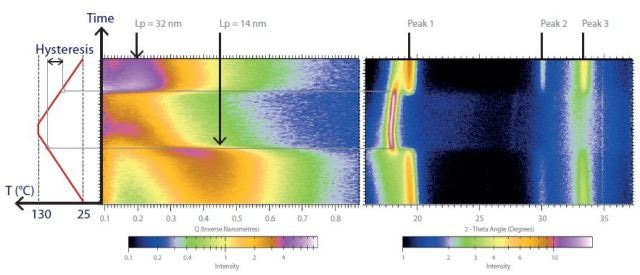Generally, polymers undergo a number of thermal transformations throughout the manufacturing process – right from their synthesis in a reactor, to product shaping processes such as film formation or injection molding. Quenching can also be a significant step in processing – for example, to preserve an out-of-equilibrium phase or a particular nanostructure orientation.
Simultaneous Small-Angle/Wide-Angle X-ray Scattering (SAXS/WAXS) is an indispensable tool for analyzing these materials, as polymers might self-organize into structures over a broad size range, from the atomic scale to several tens of nanometers.
Throughout thermal processing, simultaneous data collection can be especially informative as it allows dynamic in-situ multi-scale examination of the nanostructure, in addition to the crystalline phase, enabling the route of phase transformation to be examined.
Measurements and Results
Using the Xeuss 2.0 SAXS/ WAXS system in simultaneous SAXS/WAXS mode, a 20 µm solvent cast thick film of fluoropolymer was measured. The system was heated from room temperature to 130 °C at 1 °C/minute using an integrated temperature control stage (Linkam HFSX350).
The sample had not previously been heated. SAXS and WAXS data was gathered side-by-side with a dual detector set-up. It is known that during thermal processing, this particular fluoropolymer undergoes a ferroelectric to paraelectric transition, known as the Curie transition. This is a reversible transition, but the sample only has to be stabilized once.

Figure 1. Simultaneous SAXS (left) and WAXS (right) study of a fluoropolymer film during first heating and cooling. Ramp at 1 °C/min (far left). 2D representation of SAXS and WAXS 1D curves as a function of temperature. Each horizontal pixel line corresponds to a 1D curve.
Figure 1 shows the resulting 1D SAXS and WAXS curves as a function of temperature. These results supply data on the lamellar phase nanostructure in addition to the crystalline phase evolution as a function of temperature.
The reversible nature of the transition is clearly demonstrated by the WAXS data as the crystalline peaks remain at the same position. It is seen from the SAXS data that the long period moves from 14 nm to 32 nm after the Curie temperature is exceeded the first time.
In the following thermal cycles, no further shift of the long period is seen. So, it is inferred that stabilization was acquired after the first thermal cycle, after which the phase transition becomes completely reversible.
Conclusion
With the help of the Xeuss or the Nano-inXider SAXS/WAXS systems, in-situ experiments of polymer films as a function of thermal treatments, which could previously only be performed on synchrotron beamlines1,2, can now be conducted in the laboratory.
Xenocs SAXS/WAXS systems permit a large scope of dynamic and kinetic in-situ multi-scale studies using specific environmental control stages, like a humidity control stage or a stretching cell.
References and Further Reading
- P. Panine et al., Polymer, 2008, 49, 676-680
- Wang et al., Macromolecules, 2000, 33, 978-989

This information has been sourced, reviewed and adapted from materials provided by Xenocs.
For more information on this source, please visit Xenocs.